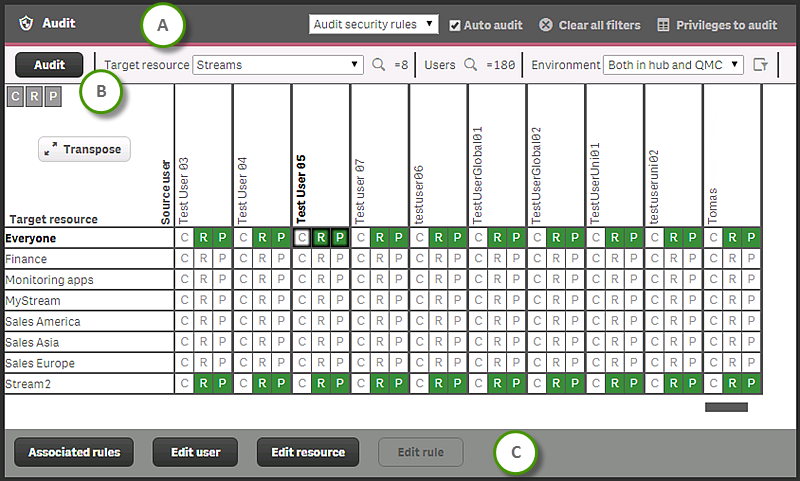On the QMC audit page, you can query for resources and users, and audit the security rules, sync rules, or license rules that have been defined in the Qlik Sense system.

| Audit overview | |||||||||||||||||||||||||
|---|---|---|---|---|---|---|---|---|---|---|---|---|---|---|---|---|---|---|---|---|---|---|---|---|---|
| A (Heading bar) |
Audit security rules drop-down list: Select the rules to audit on: security rules, sync rules, or license rules. Auto audit: When selected, all changes that are applied on the edit pages for resources, users, or rules will automatically refresh the audit table. Also, when editing, opening a security rule automatically generates a preview, if the resource type can be extracted. Clear all filters: Clear resource selection and user search query. You have to click Audit to update the grid. Privileges to audit: For security rules audits, you can select several different privileges to audit on. What privileges that are available for a particular audit depends on the selected resource. Click B to reset to the default privileges.
|
||||||||||||||||||||||||
| B (Audit bar) |
Audit: Click Audit when you have selected target resource, users, and environment. Target resource: Select the resource to audit on. Resources include the following:
License rules audit is always on login access. Users: Click F and use search to reduce the set of users. Auditing on a large number of users and resources requires a lot of server processing and may take some time. See: Searching and filtering in the QMC Environment: Select the context for the audit. .: Simulate user environment. Simulate the user environment by setting the operating system, browser, and IP address. The available settings depend on the system setup and which browser headers that are available. Example: OS=Windows; IP=10.88.3.35; Browser= Firefox; |
||||||||||||||||||||||||
| C (Action bar) |
Associated rules: Click to show the security rules that give access to the user/target combination. Edit user: Click to edit the selected user. Edit resource: Click to edit the selected resource. Edit rule: Click to edit the selected rule. (Only available when an associated rule has been selected.) Show more: Displayed when the audit generates more than 1000 results, and either users, resource, or both are unfiltered. When both Target resource and Users are filtered, all results are displayed. Information noteIf you do not have editing rights, the Edit user and Edit resource buttons are replaced by View user and View resource buttons.
|
||||||||||||||||||||||||
When you click Audit, the resulting audit table is displayed. You can pivot the table by clicking Transpose.
All green, yellow, red, or blue cells have rules attached to them:
- Green: The rule is valid and in use.
- Yellow: The rule is valid but disabled.
- Red: The rule is invalid.
- Blue: The rule is previewed.
- Dimmed values: The audit result is not fully retrieved, for performance reasons. Click Show more to get more results.
Select a cell and click Associated rules to view the details of the rules. You have also buttons for editing the user or resource.
Editing security rules or sync rules
After performing an audit, you can click a cell and then choose to display the associated rules (which can be selected for editing), or edit the user, resource, or rule. When you edit, an editing pane is displayed to the left of the of the audit page. The editing pane displays all the properties for the item being edited.
See: Editing security rules and Editing sync rules
